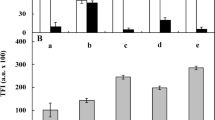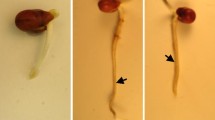Abstract
Key message
Kinetin-induced programmed cell death, manifested by condensation, degradation and methylation of DNA and fluctuation of kinase activities and ATP levels, is an autolytic and root cortex cell-specific process.
Abstract
The last step of programmed cell death (PCD) induced by kinetin in the root cortex of V. faba ssp. minor seedlings was explained using morphologic (nuclear chromatin/aggregation) and metabolic (DNA degradation, DNA methylation and kinases activity) analyses. This step involves: (1) decrease in nuclear DNA content, (2) increase in the number of 4′,6-diamidino-2-phenylindole (DAPI)-stained chromocenters, and decrease in chromomycin A3 (CMA3)-stained chromocenters, (3) increase in fluorescence intensity of CMA3-stained chromocenters, (4) condensation of DAPI-stained and loosening of CMA3-stained chromatin, (5) fluctuation of the level of DNA methylation, (6) fluctuation of activities of exo-/endonucleolytic Zn2+ and Ca2+/Mg2+-dependent nucleases, (7) changes in H1 and core histone kinase activities and (8) decrease in cellular ATP amount. These results confirmed that kinetin-induced PCD was a specific process. Additionally, based on data presented in this paper (DNA condensation and ATP depletion) and previous studies [increase in vacuole, increase in amount of cytosolic calcium ions, ROS production and cytosol acidification “in Byczkowska et al. (Protoplasma 250:121–128, 2013)”], we propose that the process resembles autolytic type of cell death, the most common type of death during development of plants. Lastly, the observations also suggested that regulation of these processes might be under control of epigenetic (methylation/phosphorylation) mechanisms.












Similar content being viewed by others
References
Azad AK, Ishikawa T, Sawa Y, Shibata H (2008) Intracellular energy depletion triggers programmed cell death during petal senescence in tulip. J Exp Bot 59:2085–2095
Barciszewska MZ, Barciszewska AM, Rattan SIS (2007) TLC-based detection of methylated cytosine: application to aging epigenetics. Biogerontology 8:673–678
Barciszewski J, Massino F, Clark BFC (2007) Kinetin—a multiactive molecule. Int J Biol Macromol 40:182–192
Berge U, Kristensen P, Rattan SIS (2006) Kinetin-induced differentiation of normal human keratinocytes undergoing aging in vitro. Ann NY Acad Sci 1067:332–336
Bollhöner B, Prestele J, Tuominen H (2012) Xylem cell death: emerging understanding of regulation and function. J Exp Bot 63:1081–1094
Bosch M, Poulter NS, Vatovec S, Franklin-Tong VE (2008) Initiation of programmed cell death in self-incompatibility: role for cytoskeleton modifications and several caspase-like activities. Mol Plant 1:879–887
Brown SE, Fraga MF, Weaver ICG, Berdasco M, Szyf M (2007) Variations in DNA methylation patterns during the cell cycle of Hela cells. Epigenetics 2:54–65
Byczkowska A, Kunikowska A, Kaźmierczak A (2013) Determination of ACC-induced cell programmed death in roots of Vicia faba ssp. minor seedlings by acridine orange and ethidium bromide staining. Protoplasma 250:121–128
Caesar K, Thamm AMK, Witthöft J, Elgass K, Huppenberger P, Grefen C, Horak J, Harter K (2011) Evidence for the localization of the Arabidopsis cytokinin receptors AHK3 and AHK4 in the endoplasmic reticulum. J Exp Bot 62:5571–5580
Carimi F, Zottini M, Formentin E, Terzi M, Lo Schiavo F (2003) Cytokinins: new apoptotic inducers in plants. Planta 216:413–421
Domínguez F, Cejudo FJ (2006) Identification of a nuclear-localized nuclease from wheat cells undergoing programmed cell death that is able to trigger DNA fragmentation and apoptotic morphology on nuclei from human cells. Biochem J 397:529–536
Domínguez F, Cejudo FJ (2012) A comparison between nuclear dismantling during plant and animal programmed cell death. Plant Sci 197:114–121
Drew MC, He CJ, Morgan PW (2000) Programmed cell death and aerenchyma formation in roots. Trends Plant Sci 5:123–127
Galluzzi L, Maiuri MC, Vitale I, Zischka H, Castedo M, Zitvogel L, Kroemer G (2007) Cell death modalities: classification and pathophysiological implications. Cell Death Differ 14:1237–1266
Gladish DK, Xu J, Niki T (2006) Apoptosis-like programmed cell death occurs in procambium and ground meristem of pea (Pisum sativum) root tips exposed to sudden flooding. Ann Bot 97:895–902
Gregersen PL, Holm PB, Krupinska K (2008) Leaf senescence and nutrient remobilisation in barley and wheat. Plant Biol 10:37–49
Gunawardena AH (2008) Programmed cell death and tissue remodelling in plants. J Exp Bot 59:445–451
Jan N, Hussain M, Andrabi KI (2008) Programmed cell death or apoptosis: do animals and plants share anything in common. Biotechnol Mol Biol Rev 3:111–126
Jullien PE, Kinoshita T, Ohad N, Berger F (2006) Maintenance of DNA methylation during the Arabidopsis life cycle is essential for parental imprinting. Plant Cell 18:1360–1372
Kacprzyk J, Daly CT, McCabe PF (2011) The botanical dance of death: programmed cell death in plants. Adv Bot Res 60:169–261
Kaźmierczak A (2010) Endoreplication in Anemia phyllitidis coincides with the development of gametophytes and male sex. Physiol Plant 138:321–328
Kobori S, Masuda Y, Horii M, Marubashi W (2007) High levels of the cytokinin BAP suppress programmed cell death in hybrid tobacco cells (Nicotiana suaveolens × N. tabacum) expressing hybrid lethality. Plant Biotechnol 24:375–381
Kratzmeier M, Albig W, Hänecke K, Doenecke D (2000) Rapid dephosphorylation of H1 histones after apoptosis induction. J Biol Chem 275:30478–30486
Kroemer G, Galluzzi L, Vandenabeele P, Abrams J, Alnemri ES, Baehrecke EH, Blagosklonny MV, El-Deiry WS, Golstein P, Green DR, Hengartner M, Knight RA, Kumar S, Lipton SA, Malorni W, Nuñez G, Peter ME, Tschopp J, Yuan J, Piacentini M, Zhivotovsky B, Melino G (2009) Classification of cell death: recommendations of the Nomenclature Committee on cell death. Cell Death Differ 16:3–11
Kunikowska A, Byczkowska A, Kaźmierczak A (2013a) Kinetin induces cell death in root cortex cells of Vicia faba ssp. minor seedlings. Protoplasma 250:851–861
Kunikowska A, Byczkowska A, Doniak M, Kaźmierczak A (2013b) Cytokinins resume: their signaling and role in programmed cell death in plants. Plant Cell Rep 32:771–780
Li S, Samaj J, Franklin-Tong VE (2007) A mitogen-activated protein kinase signals to programmed cell death induced by self-incompatibility in papaver pollen. Plant Physiol 145:236–245
McCall K (2010) Genetic control of necrosis—another type of programmed cell death. Curr Opin Cell Biol 22:882–888
Minina EA, Filonova LH, Fukada K, Savenkov EI, Gogvadze V, Clapham D, Sanchez-Vera V, Suarez MF, Zhivotovsky B, Daniel G, Smertenko A, Bozhkov PV (2013) Autophagy and metacaspase determine the mode of cell death in plants. J Cell Biol 203:917–927
Mlejnek P, Doležel P (2005) Apoptosis induced by N6-substituted derivatives of adenosine is related to intracellular accumulation of corresponding mononucleotides in HL-60 cells. Toxicol In Vitro 19:985–990
Obara K, Kuriyama H, Fukuda H (2001) Direct evidence of active and rapid nuclear degradation triggered by vacuole rupture during programmed cell death in Zinnia. Plant Physiol 125:615–626
Ovejero-Benito MC, Frade JM (2013) Brain-derived neurotrophic factor-dependent cdk1 inhibition prevents G2/M progression in differentiating tetraploid neurons. PLoS One 5:e64890. doi:10.1371/journal.pone.0064890
Palavan-Unsal N, Buyuktuncer ED, Tufekci MA (2005) Programmed cell death in plants. J Cell Mol Biol 4:9–23
Pennell R, Lamb C (1997) Programmed cell death in plants. Plant Cell 9:1157–1168
Polit J, Kaźmierczak A (2007) Okadaic acid (1 µM) accelerates S phase and mitosis but inhibits heterochromatin replication and metaphase–anaphase transition in Vicia faba meristem cells. J Exp Bot 58:2785–2797
Polit JT, Kaźmierczak A, Walczak-Drzewiecka A (2012) Cell cycle-dependent phosphorylation of pRb-like protein in root meristem cells of Vicia faba. Protoplasma 249:131–137
Reape TJ, Molony EM, McCabe PF (2008) Programmed cell death in plants: distinguishing between different modes. J Exp Bot 59:435–444
van Doorn WG (2005) Plant programmed cell death and the point of no return. Trends Plant Sci 10:478–483
van Doorn WG (2011) Classes of programmed cell death in plants, compared to those in animals. J Exp Bot 62:4749–4761
van Doorn WG, Woltering EJ (2005) Many ways to exit? Cell death categories in plants. Trends Plant Sci 10:117–122
van Doorn WG, Balk PA, van Houwelingen AM, Hoeberichts FA, Hall RD, Vorst O, van der Schoot C, van Wordragen MF (2003) Gene expression during anthesis and senescence in Iris flowers. Plant Mol Biol 53:845–863
van Doorn WG, Beers EP, Dangl JL, Franklin-Tong VE, Gallois P, Hara-Nishimura I, Jones AM, Kawai-Yamada M, Lam E, Mundy J, Mur LAJ, Petersen M, Smertenko A, Taliansky M, Van Breusegem F, Wolpert T, Woltering E, Zhivotovsky B, Bozhkov PV (2011) Morphological classification of plant cell deaths. Cell Death Differ 18:1241–1246
Zheng Z, Li L, Liu X, Wang D, Tu B, Wang L, Wang H, Zhu W (2012) 5-Aza-2-deoxycytidine reactivates gene expression via degradation of pRb pocket proteins. FASEB J 26:449–459
Acknowledgments
We thank Mrs. M. Fronczak for her help in preparing this manuscript in English and Prof. J. Barciszewski from Institute of Bioorganic Chemistry of Polish Academy of Sciences from Poznań for helpful discussion, and Mrs. E. Kuźniak-Gębarowska from Department of Physiology University of Łódź for possibility of usage Fluorescence/Luminescence Spectrophotometer F to measurements of kinase activities and ATP level.
Conflict of interest
The authors declare that they have no conflict of interest.
Author information
Authors and Affiliations
Corresponding author
Additional information
Communicated by Prakash P. Kumar.
Rights and permissions
About this article
Cite this article
Doniak, M., Barciszewska, M.Z., Kaźmierczak, J. et al. The crucial elements of the ‘last step’ of programmed cell death induced by kinetin in root cortex of V. faba ssp. minor seedlings. Plant Cell Rep 33, 2063–2076 (2014). https://doi.org/10.1007/s00299-014-1681-9
Received:
Revised:
Accepted:
Published:
Issue Date:
DOI: https://doi.org/10.1007/s00299-014-1681-9




